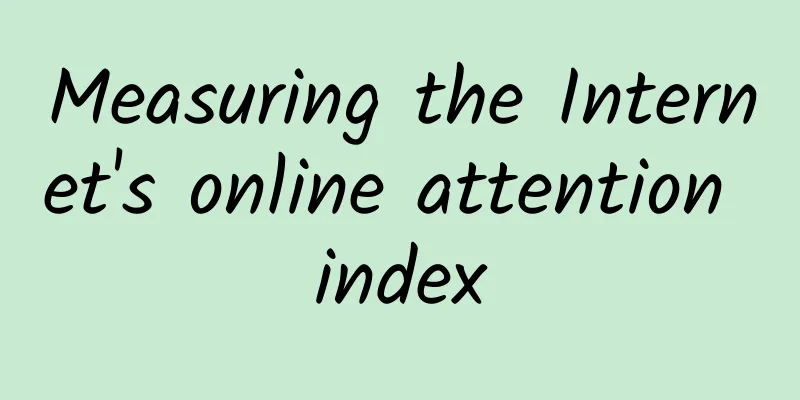Measuring the Internet's online attention index

|
To measure online attention, we need a metric, such as clicks, visitors, time spent, shares, etc. But no matter which metric is used, there will always be people who say: (1) This metric is useful and why; (2) This metric is useless and why; (3) Digital media companies often misinterpret these metrics. Page views, or hits, used to be the most important online attention metric, but have since been replaced by unique visitors, or readership. But in the virtual age, “readership” means something very different than it used to. In the 1980s, if you were a newspaper reader, readership meant you subscribed to a newspaper and received it every morning. On the Web, readership means Internet visitors who log in a few days a month at best. In the virtual age, readers can be the 1 million Facebook users who see a breaking news item, click to read it, and then leave without noticing which site they visited, and perhaps never come back to it again. Whereas readers used to be one person, they are now a spectrum. On one side are the loyal readers, on the other are the casual Facebook users, and in between are the dedicated one-time readers. They are clearly not the same for advertisers seeking sustained online attention. This is also the reason why some digital companies are trying to reduce the nature of the Internet and get closer to the nature of television. Now the video site YouTube focuses on "watch time", Medium focuses on "total reading time", Chartbeat tracks and focuses on "average interaction time", and now Upworthy has announced that it has developed a new indicator "watch minutes" to measure the time of watching or reading Upworthy pages by studying "the time a browser tab is open, the time the video player runs, and the time the mouse moves on the screen." However, the news industry's overall feedback on Upworthy's indicators is negative. For example, Felix Salmon, a writer for Wired magazine, commented on the "minutes of attention" indicator: "If I sit in front of a video for four minutes instead of two minutes, then my attention to the topic has doubled. When people share Upworthy videos, most of them never make any comments related to the video or its issues." The deeper reason is that any convenient metric has strengths and weaknesses, and some digital media companies may misinterpret them. Let’s quickly review them: Unique Visitors: Unique visitors are a good metric because they measure the number of readers per month, rather than meaningless clicks. But they are also bad because they measure the number of people, rather than more meaningful interactions. For example, Facebook accounts for the majority of traffic on many sites, where there are both one-time readers and loyal users, and the metric of monthly unique visitors does not point out the difference. Page views: This is also a good metric because it measures clicks, which is an interaction that unique visitors cannot measure. For example, a blog site with a large number of loyal users will definitely have more clicks per visitor because these users visit the site frequently. The disadvantage of this metric is the same reason that they can be misused. A 25-page slideshow about the 25 best cities for college graduates will generate at least 25 views, which is equivalent to 25 times the number of clicks on an article with the same information. If an advertiser places an ad on the slideshow page again, the page views will tell them that this page is worth 25 times more. In fact, this is a ridiculous logic. Attention Minutes: Both page views and unique visitors tell an important, but incomplete, story: the article page was loaded. But these metrics don’t tell you what happened after the page loaded. Did the reader click and leave immediately? Did he stay on the page for 20 minutes? Did he open a browser tab but never read the content? That’s what you need to know. Metrics like attention minutes tell you something, but it still doesn’t paint a complete picture. One person watched 5 minutes of a video and thought it was stupid, while another watched only 1 minute of a video but shared it with friends and gave it a thumbs-up. The latter is obviously more valuable than the former. Page views are important, as is time spent, but the reader’s reaction is equally important. This brings us to the other two metrics. Shares and mentions: "Shares" (on Facebook, Twitter, LinkedIn, Google+, etc.) obviously tell you something that page views, unique visitors, and attention minutes can't: they tell you that people didn't just visit, they took action. But what action? A bad column may cause a lot of ridicule on Twitter, and an embarrassing article will also attract attention on Facebook. Shares and mentions can measure the scale of the attention of an article, but they can't accurately tell you why people share: are they sharing out of love or out of hate? From a technical perspective, it is easier to measure digital readers than newspaper readers or television viewers. We can tell where they go based on page and tab changes, and we can track what they share and follow. In theory, this makes it easier for digital publishers to "know" their readers. But as websites enter the virtual age and articles attract a large number of attention from Facebook users, it makes people question whether the old indicators are still valuable? No matter which indicator we rely on, there are always reasons to be skeptical, and editors need to act accordingly. |
<<: Globalwebindex: Android OS usage increased from 32% to 65% in two years
>>: GWI: Three reasons why Twitter should not be underestimated
Recommend
What is the best medicine for women to take for painful urination?
Many women experience painful urination, and ther...
Yellow sticky substance discharge from lower body
If thick yellow liquid flows out from the lower p...
Treatment of left lower abdominal pain during ovulation
I believe that many of our female friends have ex...
The impact of amniocentesis on the fetus must be carefully considered
Pregnant women undergo amniocentesis mainly to se...
What is the cause of stomach pain in pregnant women for three months?
What many women worry and fear most during pregna...
International Albinism Awareness Day丨Today, let’s learn about the “Moon Child”
Are there some "special" people around ...
Will breastfeeding cause sagging breasts?
Women must remember to take care of their bodies ...
Pregnancy blood hcg index
For couples or lovers with a normal sex life, the...
Will eating siomai for breakfast make you fat? How to preserve siomai if you make too much?
Shaomai is mainly made of glutinous rice and flou...
Gynecological hemostasis and anti-inflammation methods
If women do not know how to protect their private...
38 weeks anal pain
The anus is an important organ that promotes the ...
Is it okay not to brush your teeth in the morning?
The first thing everyone does when they wake up i...
What is the difference between canned luncheon meat and ham? How to cut luncheon meat into a heart shape
Luncheon meat is a canned compressed minced meat ...
Brown vaginal discharge after menstruation
Many women know that the body will secrete some b...
The best way to remove chicken skin
In modern society, due to increased stress, envir...









